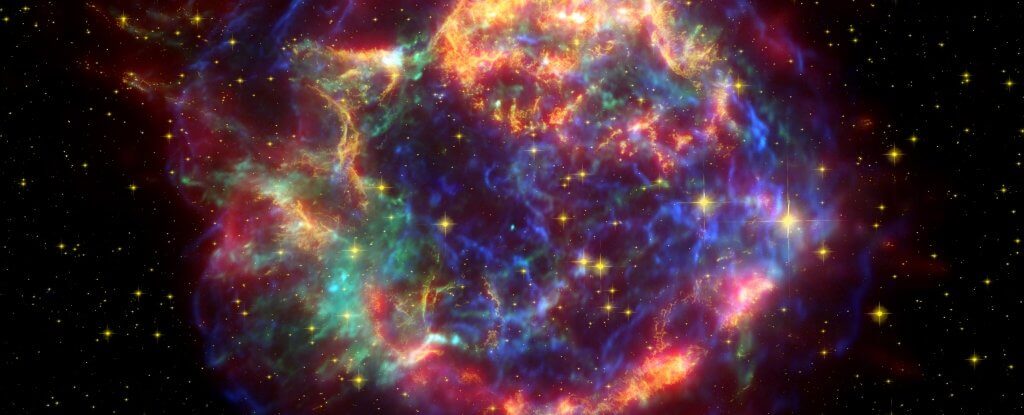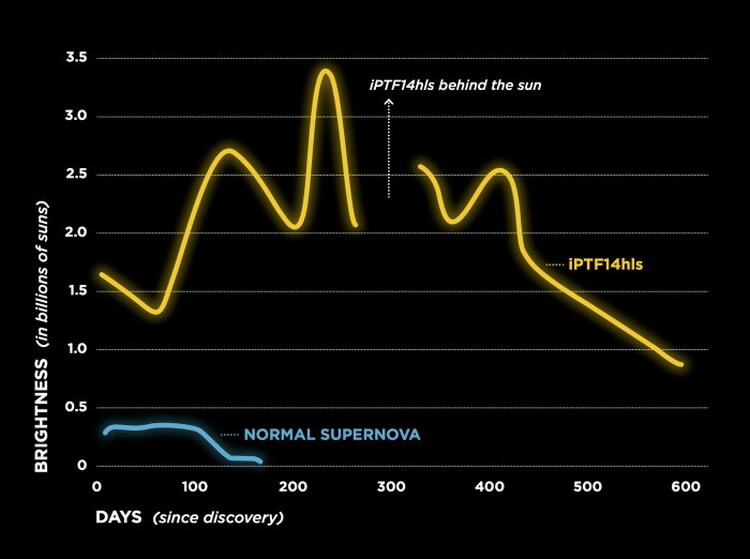
Usually when a star enters a phase of a supernova, it is a blast… in fact, it is the end. However, the new discovery astronomers can force us to revise our understanding of how stars die. Scientists have discovered a star that entered a phase of a supernova, exploded, managed somehow to survive this event, and then, 60 years later, exploded again. For explorers this turn of events was highly unusual. Just because it doesn’t have to be.
The supernova, dubbed iPTF14hls, was discovered in 2014 and at first glance it seemed quite ordinary researchers of supernovae of class II-p Supernovae of this class represent the cores of massive stars that turn into neutron star and create a powerful shock wave, passing through its outer shell, rich in hydrogen, which is released into space. The ejected matter is ionized by the shock wave, and later cools and recombines.
Observed spectroscopic features of the supernova iPTF14hls seemed completely identical for the supernova class II-P. But then, a few months later, she demonstrated a behavior that normally do not exhibit other supernova – she’s back, that is, ignited.
For 600-day monitoring period for her, she’s lackluster, a few times, and then again became brighter. In less than three years was fixed at least 5 such cases. Usually the supernova peak maximum brightness, Shine so within a few months and then start to fade. However, when scientists from the Observatory of the Las Cumbres (USA) returned to the study the archived data, they found something surprising – the same supernova exploded in 1954.

A graph of brightness (in billions suns) iPTF14hls supernova (marked by a yellow line) in comparison with the normal behaviour of the supernova (marked by the blue line) for 600-day period
“This supernova negates all that we know about these objects. It’s the biggest mystery I have ever met for almost a decade, studies of stellar collapse”, — says the head of the study, astronomer Yair Arcavi University of California, Santa Barbara and a member of the Observatory of the Las Cumbres.
The article of the journal Nature, the researchers cited estimates, according to which initially the supernova iPTF14hls was the bigger star at least 50 times more massive than our Sun, and likely much more it.
“In fact, a supernova iPTF14hls may be the largest explosion of a star ever observed,” says researcher Lars, Bildsten is the Director of the Institute for theoretical physics Kavli at the University of California.
The astronomer believes that a possible explanation for supernovae iPTF14hls could be that it is the so-called pulsating pair-instability supernova, which would make it the first of its kind facility of this type, which was able to observe actually. This event is the release of a huge amount of star stuff, which at first glance may seem a supernova, but not destroying the star.
According to scientists, this phenomenon is possible only with the stars, having mass, 95-130 times solar. During these emissions star spits out your outer layer, thereby reducing 10-25 solar masses. This can be repeated until then, until the star eventually collapses into a black hole. But this is just a guess. As an earlier candidate for the role of pulsating pair-unstable supernovae was considered the star ETA Carinae. According to scientists, it occurred 1843 ejection of matter, however, to confirm that the star belongs to this class, researchers have been unable.
“Such explosions of stars would be expected during the early Universe, but not now. It’s as if we discovered today a real live dinosaur. If such found, it would probably have wondered whether this dinosaur?”, commented Andy Howell, University of California, who heads a group for finding and studying supernovae.
It would seem that the mystery is nearing solution. But all is not so simple as we would like. The fact that the hypothesis does not account for the presence of hydrogen at a pulsating pair-unstable supernovae. After an explosion in 1954 supernova iPTF14hls kept in its shell hydrogen in a few tens of solar masses. In addition, in a later supernova explosion energy was attended by several orders of magnitude higher than described in the hypothesis of a pulsating pair-instability supernova. From this we can draw two conclusions: either iPTF14hls really is a pulsating pair-unstable supernovae, but without that unusual, or is it some completely different kind of supernova that had never been seen before.
The team of researchers continued monitoring of this supernova, and hoped that through time will still be able to find the right answer.
“This is one of those types of events on which you can literally break down. At first we thought it was a perfectly ordinary and quite undistinguished object. He then became brighter and this brightness has not changed from month to month,” says researcher Peter Nugent of the National laboratory behalf of the Lawrence Berkeley.
“After collecting all the data of our observations from the Palomar Observatory, the Keck Observatory, Observatory, Las Cumbres, and even images obtained in the framework of Malomernogo review, 1954, we will be able to get to the bottom”.
“I’d really like to find at least one similar object,” — said the scientist.
Discovered a very unusual supernova that exploded twice
Nikolai Khizhnyak